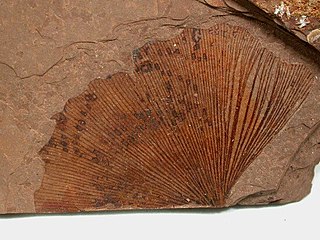The timeline of the evolutionary history of life represents the current scientific theory outlining the major events during the development of life on planet Earth. Dates in this article are consensus estimates based on scientific evidence, mainly fossils.

Polysporangiophytes, also called polysporangiates or formally Polysporangiophyta, are plants in which the spore-bearing generation (sporophyte) has branching stems (axes) that bear sporangia. The name literally means 'many sporangia plant'. The clade includes all land plants (embryophytes) except for the bryophytes whose sporophytes are normally unbranched, even if a few exceptional cases occur. While the definition is independent of the presence of vascular tissue, all living polysporangiophytes also have vascular tissue, i.e., are vascular plants or tracheophytes. Extinct polysporangiophytes are known that have no vascular tissue and so are not tracheophytes.

Ginkgo is a genus of non-flowering seed plants. The scientific name is also used as the English name. The order to which it belongs, Ginkgoales, first appeared in the Permian, 270 million years ago, and is now the only living genus within the order. The rate of evolution within the genus has been slow, and almost all its species had become extinct by the end of the Pliocene. The sole surviving species, Ginkgo biloba is only found in the wild in China, but is cultivated around the world. The relationships between ginkgos and other groups of plants are not fully resolved.

A spermatophyte, also known as phanerogam or phaenogam, is any plant that produces seeds, hence the alternative name seed plant. Spermatophytes are a subset of the embryophytes or land plants.
Guangnania was a genus of Early Devonian land plant with branching axes. It is thought to be related to the zosterophylls.
Grisellatheca was a genus of land plant with branching axes. It is known from charcoalified Early Devonian deposits, its type locality being the Brown Clee Hill lagerstatten. Its Terahedraletes spores form permanent tetrads.
Fusitheca was a genus of land plant with branching axes. It is known from charcoalified Early Devonian deposits, its type locality being the Brown Clee Hill lagerstätten. Its spores form smooth-walled, unfused, naked dyads. Its axis comprises length-parallel filaments, and their dichotomies are T-shaped, with the branches bending to continue upwards.
Culullitheca was a genus of land plant with branching axes. It is known from charcoalified Early Devonian deposits, its type locality being the Brown Clee Hill lagerstätten. Its spores formed permanent dyads.
Eogaspesiea was a genus of Early Devonian rhyniophyte with a tangled mess of branching axes that reached 10 cm in length. These probably emanated from a rhizome. Its (probably) alete spores had thin walls.
Bathurstia was a genus of scrambling Silu-Devonian land plant with isotomously branching axes that grew to heights of 30 cm. It is aligned with the Zosterophylls, and produced Calamospora-type spores.
Thrinkophyton was a genus of Early Devonian land plant with branching axes. Known fossils are of Lochkovian to Pragian age.
Gosslingia was a genus of Early Devonian land plant with branching axes. Fossils have been from the Lochkovian to the Pragian, 419 to 408 million years ago.
Serrulacaulis was a genus of early land plant with branching axes. Known fossils are of Late Devonian age.
Tarella was a genus of Early Devonian land plant with branching axes. Fossils came from Pragian age rocks.
Oricilla was a genus of Early Devonian land plant with branching axes. Fossils have been found from the Pragian to the Emsian.
Konioria was a genus of early land plant with branching axes. Known fossils are of Early Devonian age.
Deheubarthia was a genus of Early Devonian land plant with branching axes.
Anisophyton was a genus of Early Devonian land plant with branching axes. Known fossils are of Emsian age.
Odonax was a genus of Early Devonian zosterophyll with branching axes. It bore kidney-shaped sporangia and spiny branches.

Macivera is a genus of extinct vascular plants. Fossils were found in sediments in Bathust Island, Nunavut, Canada, from the upper Silurian. The leafless stems (axes) branched dichotomously and were relatively thin, being between 0.7 and 1.0 mm wide. Spore-forming organs or sporangia, which were elliptical, being longer than wide, were borne on the end regions of stems. Macivera is considered to be a zosterophyll.




